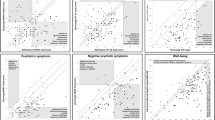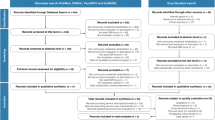Abstract
In Queensland (Australia), community-based residential mental health rehabilitation services have three distinct staffing profiles. The traditional ‘clinical’ staffing model has nursing staff occupying most staff roles. The ‘partnership’ approach involves collaboration between the health service and a Non-Government Organisation. Under the ‘integrated’ staffing approach, Peer Support Workers reflect the majority staffing component. This study compares the treatment received by consumers (N = 172) under these staffing models using cross-sectional administrative data. Staffing models were generally comparable on demographic, diagnostic, and symptomatic/impairment measures. However, statistically significant differences were present on a range of treatment variables. Differences mainly occurred between the clinical and integrated approaches, with the integrated staffing model having lower rates of involuntary treatment, antipsychotic polypharmacy, depot use, and chlorpromazine dose equivalence levels. These findings indicate the need to carefully examine the impact of staffing configuration on rehabilitation processes to understand whether differences in approaches are likely to impact rehabilitation outcomes.
Similar content being viewed by others
References
Armstrong, R. A. (2014). When to use the Bonferroni correction. Ophthalmic and Physiological Optics, 34(5), 502–508. https://doi.org/10.1111/opo.12131
Arnautovska, U., McKeon, G., Dark, F., Siskind, D., Harris, M., & Parker, S. (2021). Predictors of unplanned discharge from community-based residential mental health rehabilitation for people affected by severe and persistent mental illness. Journal of Mental Health, 30(4), 500–508. https://doi.org/10.1080/09638237.2020.1755025
Bewick, V., Cheek, L., & Ball, J. (2004). Statistics review 8: Qualitative data - tests of association. Critical Care, 8(1), 46–53. https://doi.org/10.1186/cc2428
Burgess, P., Harris, M., Coombs, T., & Pirkis, J. (2017). A systematic review of clinician-rated instruments to assess adults’ levels of functioning in specialised public sector mental health services. Australian and New Zealand Journal of Psychiatry, 51(4), 338–354. https://doi.org/10.1177/0004867416688098
Burgess, P., Pirkis, J., & Coombs, T. (2015). Routine outcome measurement in Australia. International Review of Psychiatry, 27(4), 264–275. https://doi.org/10.3109/09540261.2014.977234
Chen, J., Luo, J., Liu, K., & Mehrotra, D. V. (2011). On power and sample size computation for multiple testing procedures. Computational Statistics and Data Analysis, 55(1), 110–122. https://doi.org/10.1016/j.csda.2010.05.024
Dark, F., Patton, M., & Newton, R. (2017). A substantial peer workforce in a psychiatric service will improve patient outcomes: The case for. Australasian Psychiatry, 25(5), 441–444. https://doi.org/10.1177/1039856217700297
Harvey, C., Brophy, L., Tibble, H., Killaspy, H., Spittal, M. J., Hamilton, B., . . . Fletcher, J. (2019). Prevention and recovery care services in australia: Developing a state-wide typology of a subacute residential mental health service model. Front Psychiatry, 10(383), 383. https://doi.org/10.3389/fpsyt.2019.00383
IBM. (2017). IBM SPSS 25.0 for Windows [Computer software]. In: Author Chicago, IL.
Kakuma, R., Hamilton, B., Brophy, L., Minas, H., & Harvey, C. (2017). Models of Care for people with severe and enduring mental illness: An Evidence Check rapid review brokered by the Sax Institute (www.saxinstitute.org.au) for the NSW Ministry of Health.
Kim, H. Y. (2017). Statistical notes for clinical researchers: Chi-squared test and Fisher’s exact test. Restorative Dentistry and Endodontics, 42(2), 152–155. https://doi.org/10.5395/rde.2017.42.2.152
Leucht, S., Samara, M., Heres, S., & Davis, J. M. (2016). Dose equivalents for antipsychotic drugs: The DDD method. Schizophrenia Bulletin. https://doi.org/10.1093/schbul/sbv167
Meaden, A., Commander, M., Cowan, C., & Edwards, T. (2014). Patient engagement and problematic behaviours in nurse-staffed residential rehabilitation units. The Psychiatric Bulletin, 38(6), 260–264. https://doi.org/10.1192/pb.bp.113.045252
Meaden, A., Hacker, D., de Villiers, A., Carbourne, J., & Paget, A. (2012). Developing a measurement of engagement: The residential rehabilitation engagement scale for psychosis. Journal of Mental Health, 21(2), 182–191. https://doi.org/10.3109/09638237.2012.664301
Meehan, T. J., Stedman, T. J., Neuendorf, K. E., Francisco, I. D., & Neilson, M. G. (2007). Benchmarking Australia’s mental health services: Is it possible and useful? Australian Health Review, 31(4), 623–627. https://doi.org/10.1071/ah070623
Northwood, K., Theodoros, T., Wang, N., & Siskind, D. (2020). High-dose antipsychotic therapy and reflective prescribing: Development of an online tool for rapid, easy calculation of antipsychotic total daily dose. Australasian Psychiatry, 28(4), 410–413. https://doi.org/10.1177/1039856220917080
O’Hagan, M., McKee, H., & Priest, R. (2009). Consumer survivor initiatives in Ontario: Building for an equitable future. Toronto: Ontario Federation of Community Mental Health & Addiction Programs.
Parabiaghi, A., Kortrijk, H. E., & Mulder, C. L. (2014). Defining multiple criteria for meaningful outcome in routine outcome measurement using the health of the nation outcome scales. Social Psychiatry and Psychiatric Epidemiology, 49(2), 291–305. https://doi.org/10.1007/s00127-013-0750-7
Parker, S., Arnautovska, U., McKeon, G., & Kisely, S. (2021a). The association between discontinuation of community treatment orders and outcomes in the 12-months following discharge from residential mental health rehabilitation. International Journal of Law and Psychiatry, 74, 101664. https://doi.org/10.1016/j.ijlp.2020.101664
Parker, S., Arnautovska, U., Siskind, D., Dark, F., McKeon, G., Korman, N., & Harris, M. (2020). Community-care unit model of residential mental health rehabilitation services in Queensland, Australia: Predicting outcomes of consumers 1-year post discharge. Epidemiol Psychiatric Sciences, 29, e109. https://doi.org/10.1017/S2045796020000207
Parker, S., Dark, F., Newman, E., Hanley, D., McKinlay, W., & Meurk, C. (2019a). Consumers’ understanding and expectations of a community-based recovery-oriented mental health rehabilitation unit: A pragmatic grounded theory analysis. Epidemiol Psychiatric Sciences, 28(4), 408–417. https://doi.org/10.1017/S2045796017000749
Parker, S., Dark, F., Newman, E., Korman, N., Meurk, C., Siskind, D., & Harris, M. (2016). Longitudinal comparative evaluation of the equivalence of an integrated peer-support and clinical staffing model for residential mental health rehabilitation: A mixed methods protocol incorporating multiple stakeholder perspectives. BMC Psychiatry, 16(2), 179. https://doi.org/10.1186/s12888-016-0882-x
Parker, S., Hopkins, G., Siskind, D., Harris, M., McKeon, G., Dark, F., & Whiteford, H. (2019b). A systematic review of service models and evidence relating to the clinically operated community-based residential mental health rehabilitation for adults with severe and persisting mental illness in Australia. BMC Psychiatry, 19(1), 55. https://doi.org/10.1186/s12888-019-2019-5
Parker, S., Meurk, C., Newman, E., Fletcher, C., Swinson, I., & Dark, F. (2018). Understanding consumers’ initial expectations of community-based residential mental health rehabilitation in the context of past experiences of care: A mixed-methods pragmatic grounded theory analysis. International Journal of Mental Health Nursing, 27(6), 1650–1660. https://doi.org/10.1111/inm.12461
Parker, S., Siskind, D., & Dark, F. (2017). Thoughts on “Redefining residential rehabilitation in Australia’. Australasian Psychiatry, 25(4), 414. https://doi.org/10.1177/1039856216689534
Parker, S., Siskind, D., Hermens, D. F., Dark, F., McKeon, G., Korman, N., . . . Whiteford, H. (2019). A comprehensive cohort description and statistical grouping of community-based residential rehabilitation service users in Australia. Front Psychiatry, 10(798), 798. https://doi.org/10.3389/fpsyt.2019.00798
Parker, S., Wyder, M., Pommeranz, M., Newman, E., Meurk, C., & Dark, F. (2021b). Consumer experiences of community-based residential mental health rehabilitation for severe and persistent mental illness: A pragmatic grounded theory analysis. International Journal of Mental Health Nursing, 30(3), 733–746. https://doi.org/10.1111/inm.12842
Queensland Mental Health Benchmarking Unit (QMHBU). (2019). Community care units (CCU) Benchmarking report 2019. Wacol: Queensland Mental Health Benchmarking Unit.
Saraf, S., & Newton, R. (2017). Care or recovery? Redefining residential rehabilitation. Australasian Psychiatry, 25(2), 161–163. https://doi.org/10.1177/1039856216671662
Sharpe, D. (2015). Your Chi-square test is statistically significant: Now what? Practical Assessment, Research and Evaluation, 20(8), 8.
Shepherd, N., Meehan, T. J., Davidson, F., & Stedman, T. (2010). An evaluation of a benchmarking initiative in extended treatment mental health services. Australian Health Review, 34(3), 328–333. https://doi.org/10.1071/AH09698
Slade, M., Beck, A., Bindman, J., Thornicroft, G., & Wright, S. (1999). Routine clinical outcome measures for patients with severe mental illness: CANSAS and HoNOS. British Journal of Psychiatry, 174, 404–408. https://doi.org/10.1192/bjp.174.5.404
Stewart, V., Visser, K., & Slattery, M. (2020). Supporting choice, recovery, and participation: Clear and easy to understand information is the key to NDIS access for those with psychosocial disability. Journal of Social Inclusion, 11(2), 33–46. Retrieved from <Go to ISI>://WOS:000621810400004
Trauer, T. (2010). Outcome measurement in mental health theory and practice. Cambridge: Cambridge University Press.
Trauer, T., Duckmanton, R., & Chiu, E. (1995). The life skills profile: A study of its psychometric properties. Australian and New Zealand Journal of Psychiatry, 29(3), 492–499. https://doi.org/10.3109/00048679509064959
Acknowledgements
The authors acknowledge the staff and consumers who contributed towards the collection of benchmarking data at the different community based residential rehabilitation units. Additionally, the authors acknowledge the work of the QMHBU on which this research has been based, as well as the contribution of unit staff and Professor Tom Meehan (University of Queensland) to the manuscripts development.
Funding
No funding was received to assist with the preparation of this manuscript.
Author information
Authors and Affiliations
Contributions
SP, DJ and TS were involved in the initial study conception. SP conducted the statistical analyses and prepared the initial versions of the associated data tables. NK drafted the initial manuscript, which was subject to iterative review and revision by all co-authors. All authors approved the final manuscript version prior to publication and agree to be accountable for the aspects of the work they have contributed to.
Corresponding author
Ethics declarations
Conflict of interest
NK, DJ and TS declare they have no financial or non-financial interests to declare. SP has received honoraria from Johnson & Johnson and Queensland Psychotherapy Training, and research funding from the RANZCP, Suicide Prevention Australia, The Prince Charles Foundation, and the Mental Health Alcohol and Other Drugs Branch (Qld). SP is also on the board of directors for Mantle Housing Ltd and receives no compensation for this role.
Additional information
Publisher's Note
Springer Nature remains neutral with regard to jurisdictional claims in published maps and institutional affiliations.
Rights and permissions
About this article
Cite this article
Karan, N., Parker, S., Jones, D. et al. Cross-Sectional Comparison of Treatment Provided Under the Clinical, Integrated, and Partnership Staffing Models for Community-Based Residential Mental Health Rehabilitation. Community Ment Health J 58, 907–916 (2022). https://doi.org/10.1007/s10597-021-00898-3
Received:
Accepted:
Published:
Issue Date:
DOI: https://doi.org/10.1007/s10597-021-00898-3




